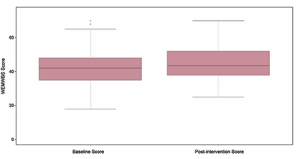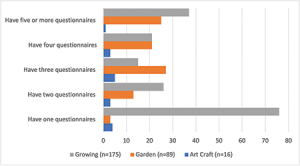An Assessment of the Change in Co-Worker Well-Being at Sydenham Gardens
Statisticians for Society (SfS) is a pro bono scheme in England that is funded by the National Lottery Community Fund and connects charities with volunteer statisticians from the Royal Statistical Society (RSS). It aims to empower charities to use their data to solve their problems. This element is key to what the RSS does, and its processes are designed to work collaboratively to understand their problems and help them understand what a statistician could do for them.
Since its inception, SfS has connected more than 50 charities with RSS volunteers who have worked on a wide range of tasks, from survey analysis to research papers. The projects can vary in time, with some lasting for a few weeks and others taking many months, but the volume of work does not affect a “day job,” and signing up as a volunteer does not imply that someone must work on a project. SfS looks for volunteers with an interest in the charity because that leads to the best results and, in many cases, to a long-term relationship between the charity and the volunteer as well.
A project to help the Sydenham Gardens charity assess the impact of its work showcases how this can work.
About the Project
Sydenham Gardens is a charitable company with a goal of promoting the physical and mental health of residents in South London. It is a unique well-being center that uses gardens, a nature reserve, and activity rooms to help people recover from mental ill-health. The primary reason doctors and health professionals refer patients to such adult mental health groups is for recovery purposes.
Mental health problems are one of the main causes of the overall disease burden worldwide, with depression and anxiety disorders being the most-common mental health conditions in the 21st century and predicted to become among the main leading causes of global disability, according to the World Health Organization.
At the time of the study, Sydenham Gardens had three projects geared toward promoting physical and mental health:
- • Garden Project. Four 2.5 hour sessions for up to 12 people per session to participate in horticultural activities, seasonal activities, conservation, cooking, and other outdoor crafts.
- • Art & Craft Project. Two 2.5 hour sessions for making handmade candles, greeting cards, cakes, preserves, and other handmade or decorated items for the organization’s spring and autumn fairs.
- • Growing Lives Project. Weekly social, therapeutic, and vocational horticultural sessions, along with the opportunity to achieve Open College Network accreditation.
The project used the WEMWBS to assess participants’ improvements in mental well-being, ability to undergo physical activity, social inclusion and interaction, developments in life outside Sydenham Gardens, quality of life, and independence and confidence. Participants fill out the questionnaire at the beginning of the project and then at quarterly intervals until it is completed.
Data
The volunteer statisticians received de-identified or anonymized data—that is, data from which all personally identifiable information was removed. The data span 2014 to 2019 and include information related to a participant’s ID number, project type, the questionnaire they filled out, and a score. Duplicates based on all variables were excluded from further analysis.
Although questionnaires had to be completed at the beginning of the project (baseline) and at quarterly intervals (four times), only a few participants were interviewed at these time points.
Figure 1 represents the total number of participants by project type and number of questionnaires filled out. Almost 30% of participants completed the questionnaire only at the beginning of the project, which may indicate that they left the project within first three months.
To evaluate the impact of the project, questionnaires have to be filled out at approximately the same time intervals, so only participants who filled out questionnaires at the baseline and at 80–100 days after (post-intervention) were included in the analysis.
Statistical Analysis and Results
The goal of the project was to assess the difference in WEMWBS scores over time and measure this difference using both clinical and statistical significance. For clinical significance, a 3-8 point difference in scores is considered meaningful. To measure statistical significance, the project first used a Shapiro-Wilk test to check the assumption of normality, then a paired sample t-test to identify whether there had been a significant change between the first (baseline or 0-day) and second (post-intervention, within 80–100 days after the baseline) questionnaire scores.
To assess whether a difference is statistically significant or not, a general minimum of at least 30 participants is recommended. Because fewer than that number participated, the difference in significance between scores in different projects was not performed.
A sensitivity analysis was conducted to assess the difference between the first and second (a questionnaire filled out within 60–120 days after the baseline) questionnaires.
The de-identified data included information about 280 participants. The majority (62.5%) participated in the Growing project, 31.8% took part in the Garden project, and the rest (5.7%) in the Art & Craft project. Only 70 participants out of 280 filled out the first and second questionnaires and were included in the analysis. The average WEMWBS score increased by 2.8 points during 80–100 days after the start of the project, from 42.2 to 45.0 (Figure 2 and Table 1).

Figure 2. Boxplot of baseline and post-intervention WEMWBS scores. Baseline score represents results of questionnaire filled out at beginning of study period; post-intervention score represent results of questionnaire filled out between 80–100 days after the start. WEMWBS score variation between participants after 80–100 days was smaller compared with baseline score. Shapiro-Wilk test shows that data were distributed normally.
A t-test found a statistically significant increase in the average WEMWBS score (mean difference 2.8 points, p-value <0.05). The sensitivity analysis included 93 participants. A t-test found a statistically significant increase in the average WEMWBS score (mean difference 2.03 points, p-value <0.005).
Conclusions
This study included only 25% of all participants who took a part in one of the Sydenham Gardens projects between 2014 and 2019. The study found a 2.8 point statistically significant increase in the average WEMWBS score 80–100 days after observing the beginning of project participation; however, a 3- or more point difference in scores is considered clinically meaningful.
For the majority of participants, the referral to Sydenham Gardens may be a last resort to improve their mental well-being. This may create difficulty in collecting data that would be more suitable for analysis.
About Statisticians for Society
Click here for more information about volunteering with Statisticians for Society.
Further Reading
Armitage, P., and Berry, G. 1994. Statistical Methods in Medical Research. 3rd ed. Oxford: Blackwell Scientific Publications.
Ghasemi, A., and Zahedias, S. 2021. Normality tests for statistical analysis: a guide for non-statisticians. International Journal of Endocrinology and Metabolism.
Stewart-Brown, S., and Janmohamed, K. 2008. Warwick-Edinburg Mental Well-being Scale (WEMWBS). User Guide.
Tennant, R., Hiller, L., Fishwick, R., Platt, S., et al. 2007. The Warwick-Edinburgh mental well-being scale (WEMWBS): development and UK validation. BMC Health and Quality of Life Outcomes.
About the Author
Violeta Balinskaite is a research associate at Imperial College London and a volunteer with Statisticians for Society. She has a PhD in mathematics from Vilnius University and PhD in statistics from the University of Bologna. Her research has focused on evaluating safety and quality of health care in England.











